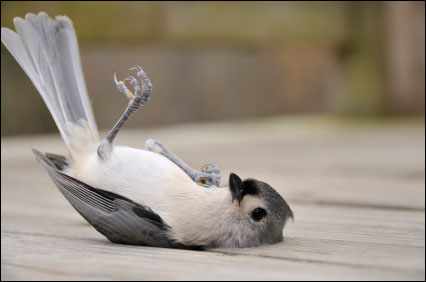The Wrong Question
Do the questions you ask yourself get you stuck or lead to what you want?
A bird hit my front window this afternoon with a startling and bone-crushing thud. I found it lying where it fell atop a leafless bush, in plain sight and defenseless, neck turned nearly upside down to its body. Its eyes were open and staring while its whole body was rhythmically moving in a kind of panicked panting.
I watched from six feet away, to avoid adding to its trauma. After three minutes, it righted its head and its eyes became more focused. After seven minutes, it started looking around and the panting ceased. At 13 minutes it suddenly jumped onto the sidewalk and hid underneath the bush. Now safe from predators, it stayed hidden there quietly for an hour, then flew away with nary a sign of injury.
That bird won’t be needing a chiropractor or psychotherapist. What does it know that we don’t about quickly recovering from life-threatening trauma?
Animal observations lead to better human treatment for PTSD
It was such observations which led Peter Levine, author of Waking The Tiger, to discover that wild animals have incredible abilities to rapidly recover from trauma. He came to understand that those same abilities exist in humans, but are often thwarted by our higher, thinking brains. From that discovery, he developed Somatic Experiencing®, a treatment method which frees the nervous system and body to remember what it once knew how to do, respond appropriately to threat and return completely to normal afterwards.
Imagine you are walking in a park barefoot on a summer day. You are content and relaxed, enjoying the warmth and leisure and gently contemplating your life. Suddenly, you feel a stabbing pain in your right foot and as you look down, you see blood.
In a instant, over 1500 physiological changes take place to save your life. Your attention goes to your foot as your nervous system responds with the”fight-flight” reaction. Gone is awareness of the warm sunshine, pleasant thoughts, and any concerns with other needs.
Your digestion and immune system go on hold. Those won’t be needed if you don’t get that bleeding stopped soon. The pain is soon numbed so you can focus on whatever is necessary to save your life.
The mind becomes clear and fast. Its job is to identify what is wrong and how to fix it. You quickly assess the seriousness of the injury, whether you need help, who is available, and how to stop the bleeding.
Your ability to ask “what is wrong and how can I fix it?” works well. Otherwise, you wouldn’t be alive to read this. Just like that bird, you are hard-wired with this life-saving response to threat.
In ideal circumstances, you get help stopping the bleeding and someone is there to comfort you. In that safety, you can allow the shock of the injury to be felt, perhaps shaking, trembling, or crying. Perhaps, like the bird, you know intuitively what to do, and take time to rest and be alone. Then you know you’re going to be okay. Those 1500 physiological changes reverse themselves and digestion and immune function are restored.
Unresolved trauma leads our brains to create habitual anxiety
But modern life in our culture is not always ideal and supportive. Many have been overwhelmed by injury, abuse, or prolonged fear and have lacked resources to recover afterward. You’re a rare person if you escaped the scars of dysfunctional families, schoolyard bullies, car crashes, loss of love, illness, violence, and the threat of nuclear holocaust.
In a life-threatening situation, with emotional or actual blood spilling, the mind’s laser-like focus on finding and fixing the problem is life-saving. But years later, if the all-clear signal was never fully sounded, this mental ability becomes a tyrannical obsession with chasing a phantom threat, long since past. Searching endlessly for “what is wrong?”, the mind re-triggers the fight-flight response, which then re-triggers the search for “what is wrong?”, like some useless computer program stuck in an endless cycle. The cycle itself is what is wrong!
If you doubt this, try a little test. Go home tonight to your significant other and start a conversation with the words, “what is wrong with our relationship?” See if your partner’s anxiety level doesn’t rise noticeably in the next few seconds, and your own, in turn. Or for a less dangerous test, simply ask yourself, “what is wrong with me?” Notice how worry arises and takes you farther from solutions than before you asked the question.
Addictions — fleeting relief from the pain and numbness of unresolved trauma
In the mind’s endless search for answers to “what is wrong?” various addictions may have offered you some temporary relief. Addictions are attempts to restore the healthy but lost experiences of pleasure, contentment, and security. But compared to the capacity of the healthy nervous system to precisely regulate your body and emotions as needed, use of these artificial substances or processes is like trying to fix your computer with a hammer.
The human mind under the influence of a “dys-regulated” nervous system is often drawn to love as the answer since a lack of loving support often contributed to the original trauma. Real love, of self, Spirit, or another, is, indeed, a powerful healer. But if the core problem of an out-of-kilter nervous system isn’t addressed, the search for love often becomes yet another addiction — to sex and romance. Looking beautiful and owning the right things to attract love become answers to “what is wrong?” And just as with other addictions, relief is fleeting at best.
Even the human potential movement, with all its books, workshops, spiritual teachers, and endless healing products, is, for many, an attempt to address this unsafe feeling — to answer the question, “what is wrong with my life that I don’t feel okay?”
Somatic Experiencing® — resolving the core problem, a nervous system out of balance
So, if the real problem is a traumatized, dys-regulated nervous system, then what does Somatic Experiencing® suggest?
The bird needed a quiet hour alone under a bush to recover from a blow which nearly broke its neck. Lacking the thinking brain of humans, it was totally connected to its body and listening deeply to genetic, sensory, and intuitive wisdom about how to heal.
If you have not done what that bird did, but have tried to “figure out your healing:”, or altogether avoid dealing with it, then your nervous system, even decades later, may have never gotten the “all-clear” signal. Your body may be chronically ready for danger, or hair-trigger reactive. Decades of frazzled nerves, overworked glands, and the reduced functioning of digestive and immune systems are the root cause of a long list of syndromes, diseases and dysfunctions epidemic in our culture today.
In a Somatic Experiencing session, the thinking mind is bypassed while the most ancient part of our brain, the part that knows how to heal, is directly addressed through the language of images and sensation. With that encouragement, creative and comforting images begin to arise spontaneously.
The skilled and caring practitioner focuses on helping you build resources, which may be internal or external, real or imaginal. They may include pleasant memories, areas of the body which feel good, favorite activities, a beloved pet, a trusted friend, a powerful place, or a spiritual guide.
If you have unresolved trauma, slowing down and being present to feelings and sensations may tend to evoke anxiety or spacing out. Strong resources counterbalance this tendency so that simply being present becomes pleasant and healing. Anxiety may discharge through movements (as the bird did), heat, tingling, or tears. The practitioner helps you to learn to trust the healing power of your resources and your own growing capacity to feel difficult feelings without getting overwhelmed.
The point isn’t merely to imagine feeling safe. Vivid mental imaging actually brings about the same physiological changes as the real experience! You’re “resetting” your nervous system, bringing it into congruence with the actual safety available in the present moment.
This will not only help calm you, but also will help restore digestion, immune system, glands, and those poor, frazzled nerves. More like the resilient bird now, you are increasing your capacity to release the trauma, then move on to new and positive challenges.
As you use this process with a practitioner’s help, then increasingly on your own, your nervous system remembers what safety feels like. You’ll have less need to grasp at things, people or ideas in an attempt to “stop the bleeding”. You’ll be able to explore the world with less fear and more curiosity and joy.
Instead of the “wrong” question, you’ll learn to ask, “what is right with my life?” then to stop and feel the answer. Your body knows exactly when it’s time to come out from underneath your bush…and fly!



